|
Monday, September 12, 2011
Progress Notes
The recent showing of the movie “Glory Brigade” at the museum last August 14, which was filmed on the Osage River at Tuscumbia by Twentieth Century Fox in 1952, brought back memories to many of Tom Edwards’ Ozark Theater in Eldon where we all went to see the movie after it was released (photo 01).
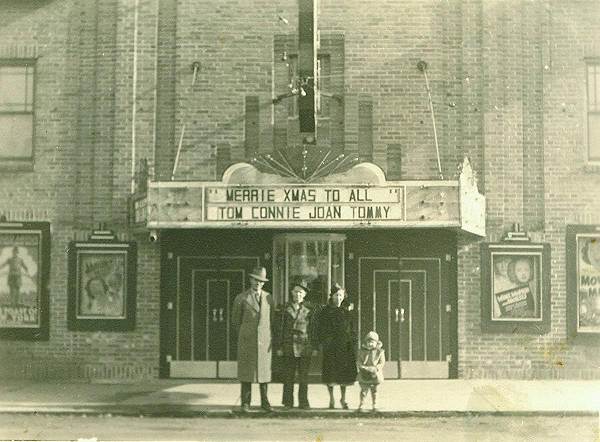
01 Eldon Theater - Tom Edwards, Tommy, Connie and Joan Edwards
When I was a boy I went to the Ozark Theater every Saturday to see a cowboy movie, usually Roy Rogers, and various serials which ran consecutively for several weeks.
Occasionally, live performances were given also. I well remember seeing Roy Acuff and his band play at the theater when I was about six years old.
Besides his fiddle playing and singing Roy could be a slapstick comedian. The day I saw him at the Ozark he said he couldn’t sing so good that day because he had a frog in his throat, and then, indeed, he pulled a big green (rubber I am sure) frog out of his mouth! Such things are remembered when one is young!
The Ozark Theater was owned by Tom Edwards who first came to Eldon in 1930. I thought some readers who may have attended the old Ozark Theater in those days might be interested in knowing more about Tom Edwards and his movie theater and film career. The following article taken from the Eldon Advertiser is an interview with Tom near the time of his retirement and discontinuation of his management of the Ozark Theater:
Tom Edwards Winds Up Four Decades In Eldon
(Copied from article in Eldon Advertiser; date not given, probably early 1970’s)
Tom Edwards, “Mr. Show Business” to Eldon for four decades, may have severed his last theater association here with sale of the Corral Drive-In, but not with the community (photo 04).
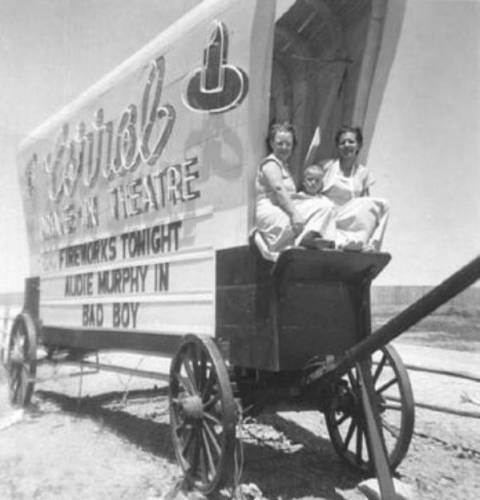
04 Corral Drive-In
“Eldon’s our home, and always will be,” he said. “We’re not going to leave it… except to spend the winters in Florida with the kids. After all, Eldon has been wonderful to me,” Edwards said, recalling his 41 years in the theater business here. “It’s given me everything I have… except my wonderful wife.”
Tom already had his wife, Connie, in 1930 when the young couple came to Eldon, and worked together to build the movie business into a No. 1 recreation attraction here. He also already had nearly a decade of theater experience under his belt, beginning in his youth when, working in Idaho, he ran a show on weekends.
Then in Idaho the young man, fresh out of college, heard about the astronomical $60 per week plus expenses film salesmen were making, and decided he was in the wrong end show business.
He went to Salt Lake City, and started at the top, seeking a sales job, using as his credentials a salesmanship course taken in college. Finally, he landed a job selling on a percentage basis.
“Nobody sold pictures on a percentage basis,” Edwards said. “I never knew of another salesman who ever did.”
He did. Working night and day, he sold pictures for a month.
“You’re through,” he was astonished to hear after that month of concentrated selling.
He quickly learned, though, that it didn’t mean he was fired. It was a humorous way of telling him he’d proved himself in the motion picture selling field, was through with the tough selling job he’d had, and was on his way as a regular salesman.
Some two years later, about 1924, he came to Kansas City as a movie salesman, and began getting acquainted with Missouri. Mr. and Mrs. Edwards had already combined motion picture sales and showing before they moved to Eldon.
They owned a theater at Lamar which Connie ran while Tom continued working his territory, which included Eldon, as a salesman for Paramount Pictures.
Their first theater here was the Electric Theater at 10 S. Maple Street, where Eldon Skelgas is now located, purchased from Harry DeWitt during the building of Bagnell Dam. In this area, construction of the dam was bolstering the economy during the depression years, and Tom recognized it.
“I was on the road, and I knew there was a depression,” he said, “but Eldon had more people in town on a Thursday night than any other five towns its size on a Saturday night.”
He got in Eldon on a Saturday night, took over the theater on Sunday, and after the first week “never had another losing week.”
He and his wife worked at it. Movie goers who grew up with them in Eldon recall the special Tuesday nights of long ago when admission was 10 cents to all, the added features like talent shows, bank nights, the dishes given away with a theater ticket, the encyclopedia, the free passes.
“We had the first Miss Lake of the Ozarks beauty contest,” he recalled.
Saturday serials kept the kids… and some of the adults… coming back.
“When a new serial started,” he said, “I’d let all the kids in the first time for a penny. And I’d get up on the marquee and throw 100 pennies into the street so they would all have the admission price. After they saw the first chapter of the serial, they’d keep coming back every Saturday.”
During the depression days, it bothered him to see youngsters outside wanting to come in but lacking the 10 cents admission price. He’d wait until someone he knew came into the movie, then he’d give him seven or eight dimes to go out and give the children eyeing the interior of the movie house longing to come in. They assumed the dimes came from the customer.
“None of the kids ever knew the money came from me,” Tom said.” “If they had, every kid in town would have been up there.”
He distributed monthly show calendars with movie news on the back, and a few comments about local people. Anyone whose name was mentioned on these calendars got a free pass to the show (photo 05).
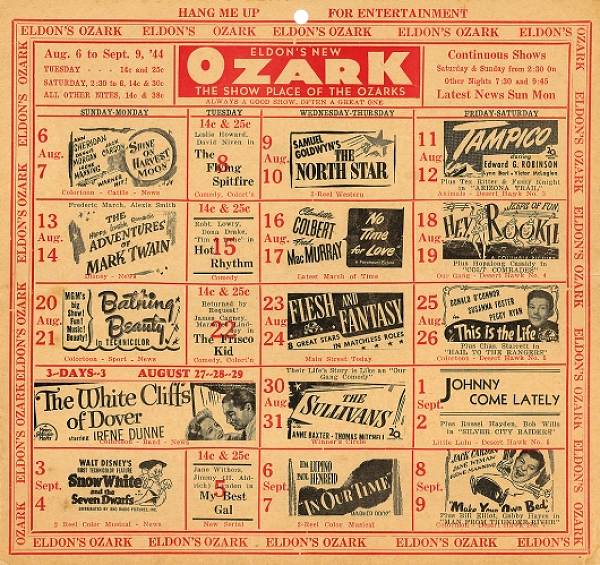
05 Ozark Theater Program
Once he unexpectedly had to treat the entire Eldon fire department, due to one of his movie news comments.
“I happened to mention that Eldon certainly had a good fire department,” he said.
“One night the fire truck pulled up in front of the theater and the whole fire department came in, pointing out on the calendar where the department was mentioned, this making them eligible for passes.”
He let them in.
By this time the Edwards’ had bought their second theater in Eldon… the Ozark… then just about two years old when they bought it from Joe T. Goshen in 1932.
They remodeled it into a stadium type theater, giving Eldon one of the most attractive theaters in the state at the time.
When the Electric was no longer used for movies, they staged weekly wrestling and boxing matches there during the days of the CCC camp at the Lake. Local talent grappled or fought it out in the ring.
And what was the most popular picture ever shown by him in Eldon?
“Jesse James,” was Tom’s prompt reply.
“I ran ‘Jesse James’ 13 times in Eldon and ‘Frank James’ seven times,” he said.
“Jesse James” popularity here wasn’t just because one scene was filmed at the Lake, he contended, or because of the Missouri interest in the James legend.
“It was a good picture,” he said, “with Tyrone Power in the title role.
Note: You can read more about the making of the movie, Jesse James, and the famous leap over the bluff of Jesse and Frank James on their horses filmed on site at the Lake of the Ozarks at this previous Progress Notes.
Comedy, westerns and good family pictures with Will Rogers and Shirley Temple went over big with Eldon audiences in those days.
“Or course, if you had a Roy Rogers or Gene Autry picture, it was just like money in the bank,” he said.
Although the Edwards’s have sold their last theater interest here with the sale of the Corral Drive In to a former Ozarks and Corral manager, Bill Smith, they’re still in the theater business in the Lead Belt area of southeastern Missouri.
For a time they lived in Farmington, moving there in 1947 after purchasing the Lead Belt Circuit in conjunction with Harold Harrison of Kansas City. They still have the Roseland Theater in Flat River and the Corral Drive In, a 1000 car theater between Farmington and Flat River, and own the P.N. Hiersch Department Store building in Farmington.
They were living there in 1950 when the Ozark Theater in Eldon burned.
They came back to rebuild it and also, in 1952, to build the Corral Drive In Theater here, a namesake of the one in the Lead Belt area.
Theaters have changed a lot since those days of the 1930’s when the Edwards’ started to make motion pictures big news here. Many recall the torrid summers of 1934 and 1936 here. Neither the Electric nor Ozark was air conditioned at first, but had cooling systems, to make it comfortable for crowds that sometimes reached standing room only proportions.
At the 250 seat Electric, a big blower fan was used. At the Ozark, the theater was equipped with 300 little fine spray nozzles. The air was brought through the spray which was so fine it cooled the air.
“It was sort of an evaporation deal,” Tom explained. “Fans took any moisture out before the cool air went through ducts into the auditorium.”
The theater owner not only became well known in Eldon but also throughout motion picture circles during his residence here. He’s the only man in Missouri, Kansas and Illinois that has served as president of both the Western Missouri and Kansas Theater Owners Association, and the Eastern Missouri and Southern Illinois Theater Owners Association. He also has been on the national board of Theater Owners of America.
Tom was one of 20 theater men from throughout the United States selected to go to Hollywood in 1952 for a round table meeting with film company presidents and representatives, writers, actors, producers, directors…all segments of the industry for three days the group of 100 sat down to talk show business.
He’s also become widely known through the years as a master of ceremonies, emceeing events in most of the country’s major cities from Los Angeles to Miami.
In Eldon he twice served as president of the Chamber of Commerce, heading it when the community got the Airpark and when it got International Shoe Factory. He was the Airpark’s first commissioner, and first president of the Eldon Golf Club.
Only two men are still active in Eldon’s business world who were in business when he came to join them here: G.W. Smith and Harry Tompkins (photos 10 and 11).
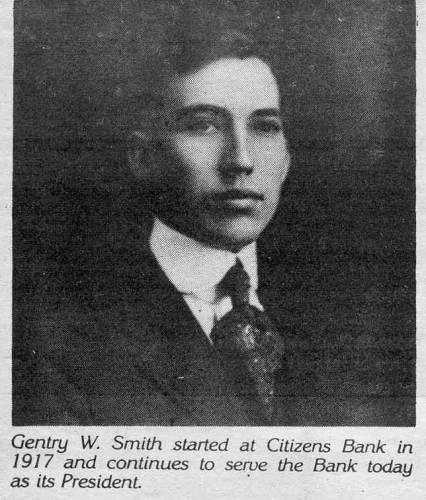
10 Gentry Smith
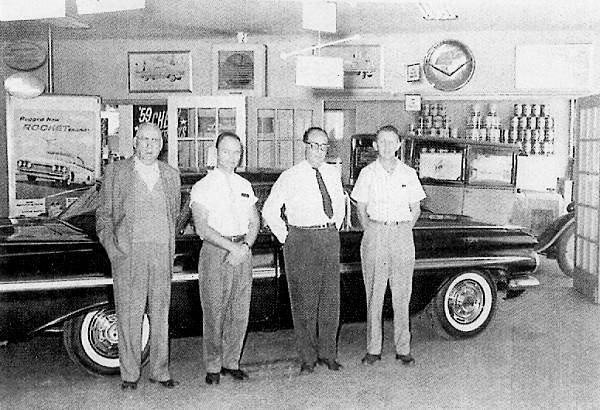
11 C.T. Tompkins, Tom Proctor, Harry Tompkins and Gene Milburn
Mr. and Mrs. Edwards have two children, neither of whom has followed them into show business… Tom and Mrs. Jack Needy, the former Jodie Edwards. Young Tom was briefly associated with his parents in the theater business, but decided to start out on his own. He and his brother in law, Jack Needy, now have their own real estate company, Fort Lauderdale Realty Company in Florida.
Six of the Edwards’ seven grandchildren also live in Fort Lauderdale. Their other granddaughter and their one great grandson live nearby in central Florida.
So Tom and Connie have lots of attractions to draw them to Florida in the winter season. But the remainder of the year finds them here where, after selling their larger house, they have a smaller home on the bank of their Corral Lake just south of the city.
“I like it better than any place I’ve ever lived,” he said. “In the morning I’ve sat out on the porch drinking a cup of coffee, seen a fish jump, put the coffee down, go out and caught it, and turned it loose again. Then I come back, wash my hands, and finish my coffee.”
Neither Tom nor Connie takes an active part in the Lead Belt theaters now except for one time during the year…the big Fourth of July event there when they go down to help out in the concession stand.
Between the sales end and the theater end of motion picture business, Tom’s approaching a half century in the film business.
“I just don’t know how I’ve been in the business so long when I’m only 39 years old,” he said.
Mike Wieneman was the one who sent me the old movie schedule for the Ozark Theater which Tom Edwards sent out each week to various businesses and other public outlets as well as mailed to people’s homes (photo 05 above). The Ozark Theater was a very popular venue for entertainment for Miller County residents, especially in the early 1930’s during the depression days. I have been told by several people that, not having a car, they would walk the entire twelve miles from Tuscumbia to Eldon to watch a Saturday matinee.
Mike gave me some more information he had about Tom’s theaters in Eldon:
“The Ozark Theater was Eldon’s second theater in Eldon. It was opened in the late-1920’s or early-1930’s in competition to the nearby Electric Theater owned by Tom and Connie Edwards. However, it was eventually taken over by Tom and Connie and later was owned by the Edwards and Plumlee Theatres chain (which may have been co-owned by Tom and Connie Edward or their descendants).
The Ozark Theater was located at the corner of Maple and North Streets. I am not sure when the Ozark Theater closed, but believe it lasted into the 1970’s or 1980’s.”
Near the Corral Drive In Theater owned by Tom featured in photo 04 above was another entertainment venue owned by Tom, “Tom’s Monkey Jungle.” Here are some photos of the Monkey Jungle taken from Dwight Weaver’s book, “Lake of the Ozarks Vintage Vacation Paradise (photos 12 - 15):”
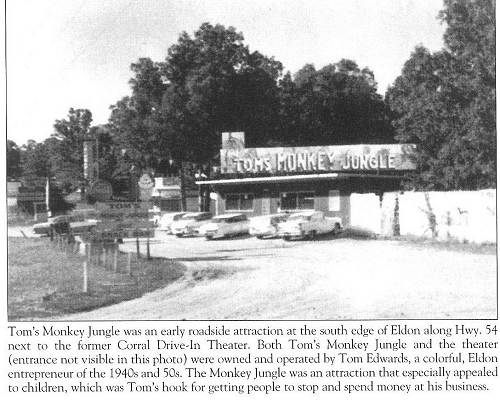
12 Tom's Monkey Jungle
Click image for larger view
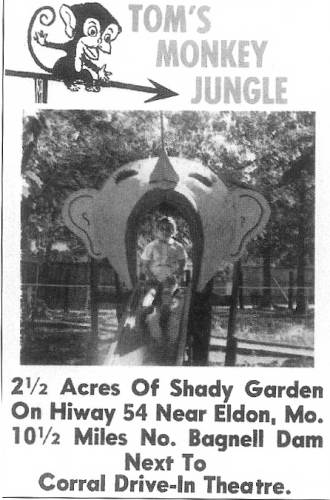
13 Tom's Monkey Jungle
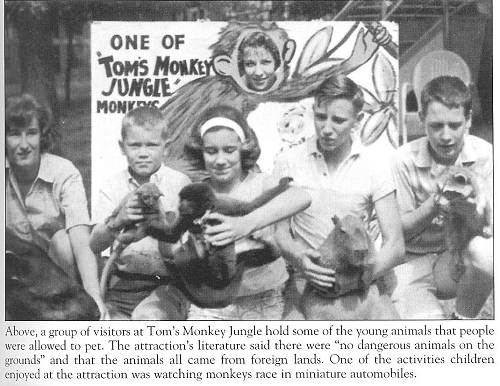
14 Tom's Monkey Jungle
Click image for larger view
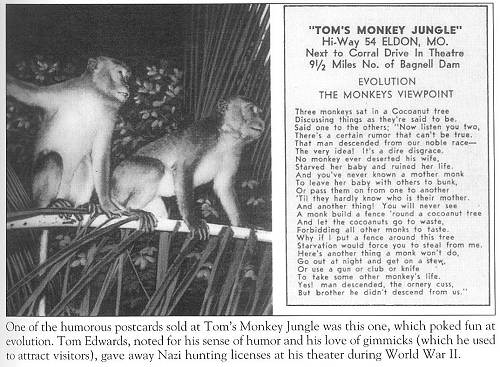
15 Tom's Monkey Jungle
Click image for larger view
Tom always had a big car and in the early days he drove a big Packard, according to Wallace Vernon.
Note: You can read more about Wallace’s comments about the cars driven around Eldon years ago at this previous Progress Notes.
Never one to miss an opportunity to advertise, Tom sponsored a float in the 1937 Miller County Centennial Celebration at Tuscumbia. The float advertised the current movie showing then at the Ozark Theater in Eldon, “The Good Earth” starring Paul Muni (photo 16).
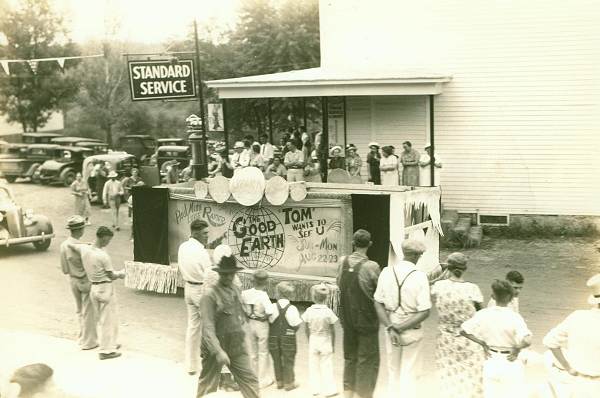
16 The Good Earth - Miller County Centennial - 1937
Although Tom was not born and raised in Eldon, he chose the town as his final resting place after his death November 17, 1980. Here is the obituary of Tom printed in the Eldon Advertiser:
“Tom W. Edwards, 80, Eldon, Missouri, died Monday in Fort Lauderdale, Florida. He was born August 20, 1900, at Rock Springs, Wyoming to Thomas and Margaret Jenkins Edwards. On September 23, 1921, he married Constance Nibley in Logan Utah. She died August 18, 1980.
Tom lived in Missouri since 1927. He owned and operated movie theaters in Eldon and Farmington, Missouri from 1929 until his retirement.
Tom was a member of the Church of Jesus Christ of Latter Day Saints.
Survivors include one son, Tom N. Edwards, Fort Lauderdale, Florida; one daughter, Mrs. Jodie Needy, Columbia, Missouri, two sisters, Mrs. Margaret Ruth Worley, Great Falls Montana, and Mrs. Lucille Gasser, Pocatello, one brother, M.J. Edwards, Honolulu, Hawaii, seven grandchildren, and three great grandchildren.
Funeral services will be Saturday at 11 a.m. at the Phillips Funeral Home in Eldon, Missouri, with Bishop Don Weems officiating.
Burial will be in the Eldon City Cemetery.”
Those of us who lived during the era of Tom Edwards in Eldon will always have fond memories of the good times we shared at his several entertainment venues in Eldon.
Another enterprise in Miller County which eventually became our largest entertainment attraction appeared about the same time that Tom Edwards was entertaining Miller Countians at the Ozark Theater. Of course, this was Bagnell Dam and the Lake of the Ozarks. I found an article in the Eldon Advertiser which described the very first holiday celebrated at Bagnell Dam after it was finished in 1931:
Remember The First Holiday At The Lake of the Ozarks (photo 17)?
Eldon Advertiser
June 8, 1978
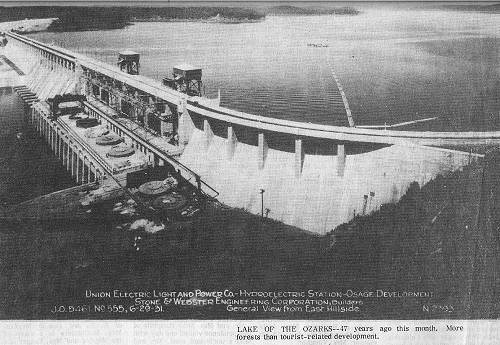
17 Bagnell Dam - 1931
Click image for larger view
How many of the quarter of a million or more who flock to the Lake of the Ozarks for the weekend remember the first of these holidays in the Lake area? It was back on Saturday, May 30, 1931 that Highway 54 was officially opened for traffic over the then called “Osage Dam,” now known as Bagnell Dam.
That first Saturday 47 years ago 1,771 cars crossed the dam, and on Sunday, 2914 cars were counted passing over the dam. Many visitors parked on either side of the Osage River, and did not make the motor trip across.
By Saturday night of that Memorial weekend, visitors had flocked to Eldon on their way to the dam, and they took residents by surprise. By 8 p.m. hotels were full in the city and 126 people had called for rooms at the James House, now the site of Tompkins Chevrolet car lot of South Maple Street, than could be accommodated (photo 18).
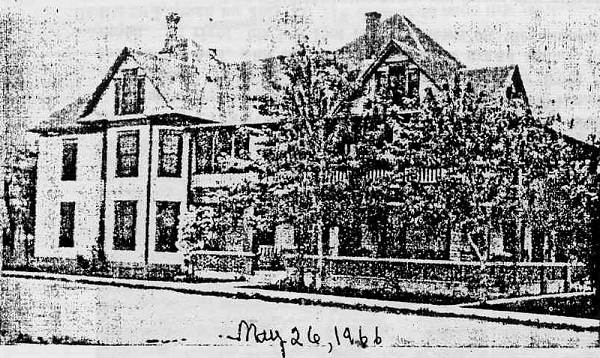
18 James Hotel
Hotel managers and personnel of service stations, cafes and other business places called citizens of the city and many took the tourists into their homes overnight, providing breakfast the morning.
Residents in nearby Etterville, Barnett and Versailles were also contacted in an effort to accommodate the influx of tourists, just a fraction then of what was in store for the future.
Waters of the Lake of the Ozarks had risen to 659.6 feet by midweek. Here’s the way the Advertiser described the Lake 47 years ago:
“The waters are clear and with the green bluffs and hills extending along either side of the lake the scenery is wonderfully beautiful. Speed motor boats are making pleasure trips over the lake from points where the scenery is the best and where landings are most accessible.”
Memorial Day weekend, 1931, was marked by a special event in Horseshoe Bend. Members and friends of Riverview Church in Horseshoe Bend enjoyed a reunion and all day service with basket dinner Sunday, May 31, 1931. A table 70 feet long was spread and loaded with good things to eat.
About 400 gathered early for a social day and for worship at the old church which was to be abandoned as all members had moved out of the Horseshoe Bend where the Lake of the Ozarks was spreading its waters over their former river bottom homes.
The church building there had a 30 year history before the lake moved in, according to the history given at this 1931 meeting. W.H. Downing deeded four acres of land to the Riverview church and a building was erected in the Bend in 1931.
The history of the church and a roll of members were included on the program at its present site, Highways 54 and 42, but back in 1931 members made plans to have annual reunions at the church site in Horseshoe Bend, high above the lake waters.
Roads were still gravel when those first tourists came to the Lake of the Ozarks for the summer season, 1931, including Highway 54. But road improvements were a prime concern in the area.
Improvement of the Eldon California road was reported making good progress. The course of the Moreau near the Miller Moniteau line was to be changed and a concrete high water bridge was being built 100 yards south of the low water bridge at the John Campbell farm. The bridge was being erected by the county courts of the two counties and the Eldon Special Road district (This one lane bridge has since been replaced by the present two lane Highway 87 bridge).
“When completed the road between Eldon and California, which has been one of the roughest main roads in this part of the county, will be almost a highway,” the Advertiser noted in 1931.
Morgan County was getting in step, too. There it was reported a new piece of county road was being built toward the mouth of the Little Gravois.
“The new road leaves Highway 5 at a point seven miles south of Versailles and proceeds for two miles in an easterly direction,” the Versailles Statesman noted 47 years ago. “The new road will lead to Gravois Beach, one of the most promising resort developments on the Lake. As soon as this road is finished, the machinery will be moved to a point below Gravois Mill and an old country road rebuilt toward the lake which will also make accessible two large summer resort properties which are now being subdivided into small acreages.”
By the next year, Highway 54 north of the dam was being paved. They hoped to have it ready for the 1932 Fourth of July picnic at South Bagnell, but, if not, traffic would be routed across the dam by way of Union Electric land rather than the necessity of making the eight mile detour by way of the Bagnell ferry. The highway had been closed from the Bagnell road to south of the dam during June, 1932 for laying of the Highway 54 pavement.
Though roads were gravel back in 1931, replacement of cars worn out on the rocky roads was inexpensive. Here are some of the used car prices quoted in June, 1931: 1927 Chevrolet roadster,$125; 1929 Essex sport coupe, $315; and a 1930 Ford coupe that “looks and runs like a brand new car, $385.” There were such other bargains as a four year old Pontiac coach for $135 and a four year old Chevrolet truck, $165.
Here is a photo of Bagnell Dam and the Lake Ozark strip taken in 1973 which reveals how much commercial development occurred as compared to the photo above taken soon after the dam opened in 1931 (photo 19):
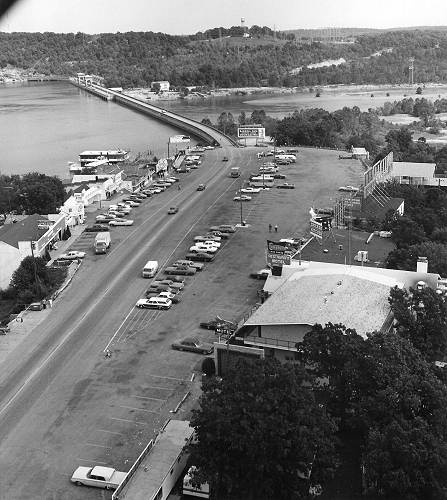
19 Bagnell Dam and Strip - 1973
Recently, I came across an old article in the Eldon Advertiser which was a double obituary for Mr. and Mrs. William Dixon Simpson of Spring Garden who died in March of 1936, Mr. Simpson on March 23 and Mrs. Simpson on March 21 (photo 20).
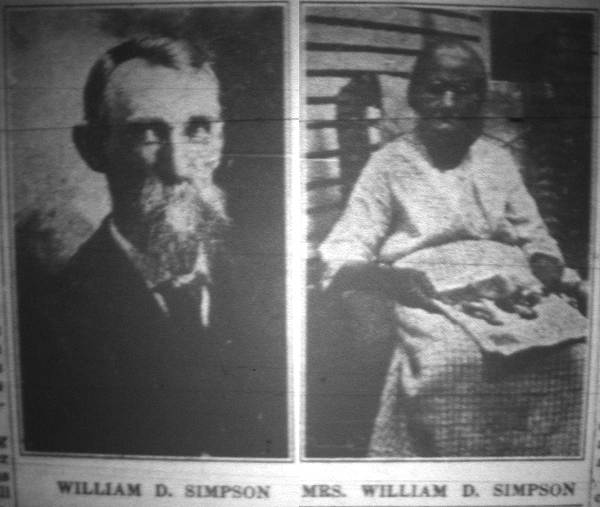
20 Mr. and Mrs. William Simpson
At the time they were the longest married couple in the county as far as could be determined by the author of the article. Probably, that county record has been broken a few times by now some seventy five years later; I know that my Uncle Arthur and Lena Bear of Eldon were married 73 years before he passed away in 2006.
Here is a copy of the article:
Eldon Advertiser
March 23, 1936
Double Funeral Held For Couple Married Seventy Years
Mr. and Mrs. W.D. Simpson Die Two Days Apart
Spent Life Near Spring Garden on Farm Deeded Mr. Simpson’s Father From Government
The double funeral of Mr. and Mrs. William Dixon Simpson of Spring Garden, was held at the Baptist Church there Tuesday afternoon by the Reverend B.F. Dinwiddie, pastor evangelist of Eldon. Burial was made in one grave at the Spring Garden Cemetery.
Mr. and Mrs. Simpson were married November 14, 1865, and had lived in Miller County since that time. Their seventy years of married life was probably the longest nuptial relationship that is recorded in the county.
With the exception of five years they had lived in California, they spent their entire life on part of the original tract of land Mr. Simpson’s father, Robert E. Simpson, was deeded by the government. The name Robert E. Simpson is mentioned in Gerald Schultz’s Miller County History as associate judge in 1842 and 1854, and representative of Miller County in 1856. Robert Simpson settled in Miller County in 1828 and his name appears early in Miller County history associated with those who came to the county from Kentucky before 1860. That there were few families in Miller County at the time is certain because in 1840, when the first census was taken in the county, there were but 2,282 persons enumerated and 489 of those were in Saline Township where Spring Garden is now located.
Mr. William Dixon Simpson said in November 1929, when Mr. and Mrs. Simpson celebrated their sixty fourth wedding anniversary, that when his father moved to what is now Spring Garden, the country there was wild and that this part of Saline Township was then a part of Cole County. He said he hunted deer and other wild animals on the prairie where Eldon is now located. He was born there September 16, 1847.
Here is the obituary of William Dixon Simpson:
William Dixon Simpson, son of Robert E. and Keziah Greenup Simpson, was born September 16, 1847 at Spring Garden, Missouri, and was married to Sarah Jane Henley, who was born January 27, 1850, the daughter of James Henley and Nancy Duncan Henley. Mr. Simpson died March 23, 1936 and Mrs. Simpson, March 21. They are survived by six children: Otto Simpson of Kansas City, Nathan Simpson of Chicago, Ira Simpson at home, Mrs. Ida Muir of Versailles, Mrs. Addie Johnston at home, and Ada of Tulsa, Oklahoma; three grandchildren, William Simpson and Mary Kathryn Simpson of Kansas City, and Mrs. Louise Taylor of San Francisco. All were present for the funeral except Mrs. Taylor.
Here are photos of the William Simpson tombstone in the Spring Garden Cemetery taken from the Find A Grave Website submitted by our museum director, Nancy Thompson (photos 21, 22 and 23):
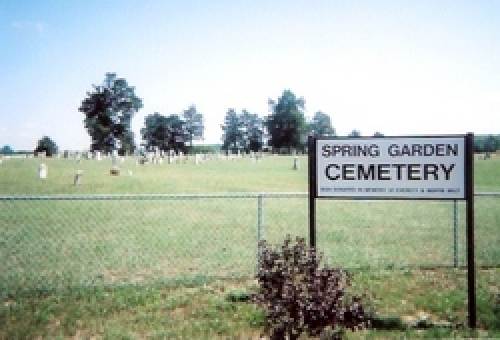
21 Spring Garden Cemetery
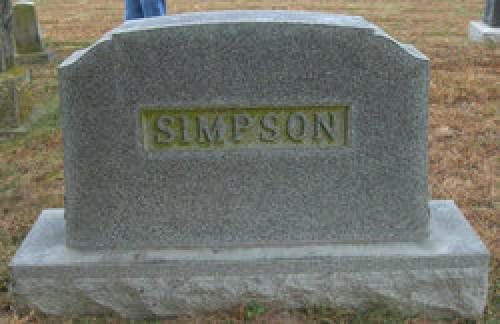
22 William Simpson Tombstone - Front
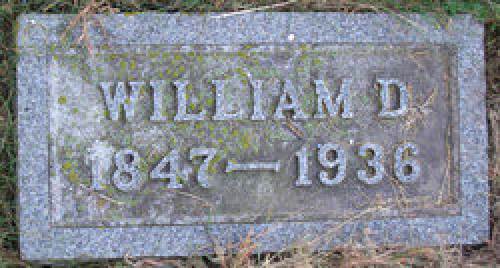
23 William Simpson Tombstone - Back
And here is the Find A Grave website where you can read more about William as written by Nancy Thompson, our museum director.
One thing that interested me about Mr. Simpson is that his father, Robert Enoch Simpson, was one of the earliest settlers of the county having come to the Spring Garden area in 1834. Helen Gibson, a former Miller County Historical Society board member, is a descendent of Robert Simpson. She gave me the following information:
One of Miller County's early pioneers, Robert Enoch Simpson, was born December 23, 1807 in Kentucky. On September 11, 1828, he married Keziah Greenup. In 1834, Robert and Keziah moved to Missouri, where they settled just across the Cole County line in Saline Township. This is now the site of Spring Garden, Missouri. They were the parents of nine children.
In 1850, their oldest son, John, at the age of 20, left Missouri with a party of fellow Missourians. They rode horseback to Fresno, California, where John became an early California pioneer. John's brother, Thomas W., joined him in California in 1857. Thomas owned 258 acres of land in Miller County. One of these tracts of land, north of the Saline Creek, had a lot of lead mines. Later Thomas sold the land with the mines to his brother John. Jasper N. Henley, John’s brother-in-law, had the power of attorney to act as his agent regarding the land. Huge deposits of lead were found on this land in 1869.
The lead mine Thomas Simpson sold later was bought by some St. Louis investors and was named the Gageville Lead Mine, one of the largest deposits in the county.
But what was even more interesting to me was the significant part that William and Thomas’ father, Robert Enoch Simpson, played in the early development of our county. According to Goodspeed’s History of Miller County p. 569:
“Judge R. Simpson entered the land on the site of Spring Garden about 1830, and in 1868 the first building to be erected was Spring Garden Seminary.”
And on p. 536:
“The first store in Miller County was no doubt in Spring Garden, and was owned by Landsdown and Dixon in the early half of the 1830’s. Robert Simpson and Thomas Dean sold goods there later.”
More information about Robert Simpson is found on our website which records the history of Spring Garden:
From History of the Spring Garden Community:
The Spring Garden settlement first appeared on an official plat of the state road leading from Lisletown on the Osage River in Cole County west toward Versailles on Feb. 15, 1847, county historian Clyde Lee Jenkins discovered on an old road plat found at the courthouse.
It shows the road leading past Martha Farmer's residence just over the line in Cole County, Martin Bond's astride the county line, the church, Thomas Sullen's tanyard by the spring, R.E. Simpson's house, S.C.H. Witten's house, Robert Belshe's, Alfred Carrender's, Franklin Belshe's, Mrs. Hough's and on west past BENJAMIN HINES' to Rosannah Etter's house.
Robert E. Simpson and BENJAMIN HINES were among the larger property owners of the area as indicated in 1859 records checked by Jenkins. Hines owned 1,404 acres south of what is now Etterville plus 17 slaves valued at $10,200. Simpson owned 7 slaves valued at $3,800 and 1,717 acres in Miller County and other land over the line in Cole County.
Although Robert Simpson lived in the northern part of Miller County, which in those days was at least a day’s horseback ride to Tuscumbia, he was actively involved in county affairs serving as a judge on the county court according to Goodspeed’s history of Miller County (p.541). In that capacity he was involved with the construction of the first bridge across Shut In Branch Creek in Tuscumbia, which lead across the creek to where the Riverside Park is today (photo 24).
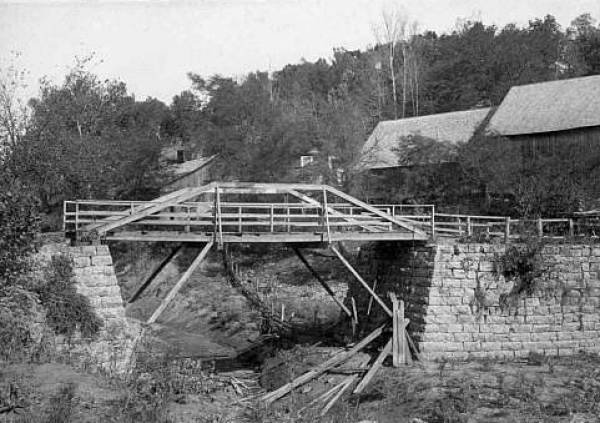
24 Shut In Branch Bridge
Simpson, having come from Kentucky, was one of the county’s major slave holders having at one time as many as nine slaves.
Judge Clyde Lee Jenkins in his book, “History of Miller County,” records nineteen references to Robert Simpson:
p. 35 1835 patented land
p. 82 paid warrant by county
p. 92 overseer Road District 5
p. 114 on commission for Lisletown Versailles Road
p. 169 on county court, adjourned to clerk’s office
p. 224 on list of slave owners having seven slaves worth 3800 dollars
p. 228 among a group who provided security for bond of Jane Hinds estate
p. 229 on list of slave owners having eight slaves
p. 230 bought two slaves at sale
p. 233 on list of slave owners having 9 slaves
p. 272 judge of county court, officiated marriage
p. 273 officiated marriage
p. 274 officiated marriage
p. 275 officiated marriage
p. 277 officiated marriage
p. 280 officiated marriage
p. 281 officiated marriage
p. 338 appointed commissioner to oversee construction of bridge over Shut in branch
p. 419 paid 320 dollars assessed for being secessionist
As was his son William, Robert Enoch Simpson was buried in Spring Garden Cemetery and his old tombstone recently was found by Nancy Thompson, our museum director lying broken next to the fence (photos 25 and 26).
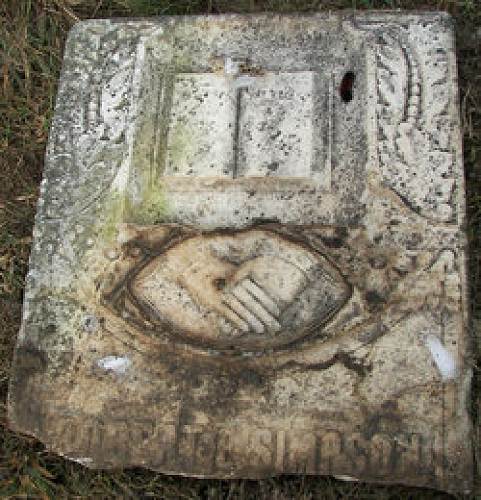
25 Robert E. Simpson Stone
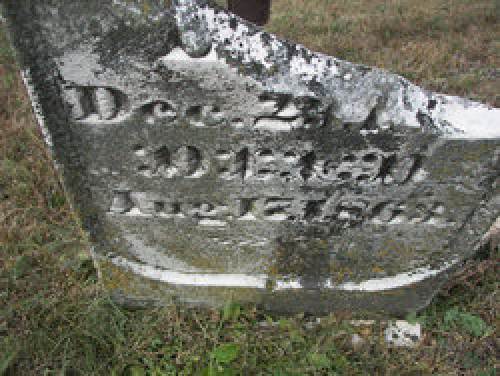
26 Robert E. Simpson Stone
Here is where to go for the Find A Grave website for Robert Enoch Simpson written by Nancy.
So while my initial interest regarding this narrative was in reference to the longevity of the marriage of William and Sarah Jane Simmons, further research found that the Simmons family was one of the first to arrive in Miller County participating in much of its early development.
One of my volunteer activities is as a member of the Tuscumbia Alumni Association committee which is chaired by Larry Flaugher. Our association is holding a fund raiser which Larry has named the “Pig and Pickle Fest” to be celebrated at the Tuscumbia Riverside Park Saturday, September 17, 11 am to 7 pm. Beneficiaries are Miller County Special Olympics, Tuscumbia Alumni Association, and the Village of Tuscumbia. Featured will be BBQ and fried dill pickles accompanied by great music and a car show. Here is the flier Larry designed for the occasion which gives more detail (flier).

2011 Pig and Pickle Fest Flier
Click image for larger view in PDF format
If you want to have a really good time plan to attend the event which I anticipate will be very enjoyable and fun.
That’s all for this week.
 Joe Pryor
Previous article links are in a dropdown menu at the top of all of the pages.
|

